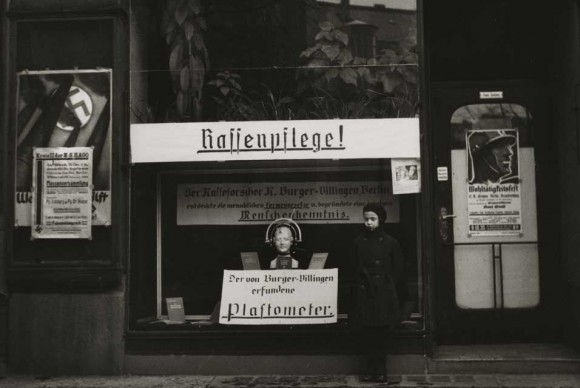International Center of Photography Acquires Roman Vishniac Archive
NEW YORK, NY.- The International Center of Photography today announced the acquisition of the entire archive of work by renowned photographer Roman Vishniac. The Vishniac archive provides a comprehensive record of his photographs, including prints of many celebrated images of Eastern and Central European Jewish life before the Holocaust, thousands of others never-before-seen, as well as his noted microphotographic imagery. The archive was donated to ICP by Vishniac’s daughter, Mara Vishniac Kohn, in recognition of her father’s long-standing friendship with ICP founder Cornell Capa.
“This is one of the most important acquisitions in the thirty-five year history of the International Center of Photography,” said ICP’s Ehrenkranz Director Willis Hartshorn. “We look forward to sharing this extraordinary gift with our audience through exhibitions, publications, and online access. And the donation is particularly meaningful to us as a gesture of devotion and support from our dear friend Mara Vishniac Kohn. We appreciate that she would trust us with maintaining her father’s legacy.”

Roman Vishniac, Mara Vishniac poses in front of a device for measuring the difference in size between Aryan and non-Aryan skulls, Berlin, 1933. © Mara Vishniac Kohn
Roman Vishniac (1897–1990) was one of the foremost documentary photographers of the twentieth century and he is especially revered for his unparalleled presentation of pre-Holocaust Jewish life. Born in Leningrad and raised in Moscow, he was fascinated as a young man by microscopes and photography. After immigrating to Berlin in 1920, he married his first wife Luta, with whom he had two children, Wolf and Mara. In 1935, Vishniac was commissioned by the Jewish Joint Distribution Committee to photograph impoverished Jewish communities in isolated rural locales and small villages, industrial towns and large cosmopolitan cities, documenting urban poverty, the effects of rampant dislocation, crippling economic conditions and anti-Semitic boycotts, in an effort to call attention to and alleviate their plight. The resulting images became the most iconic and extensively reproduced documentation of the people in these communities, and of the places in which they lived and carried on their daily activities. As a scientist, he was also responsible for major advances in the fields of photo microscopy and time-lapse photography, and produced important bodies of work in these realms as well. Vishniac’s continued image-making in New York after his arrival in 1941 included documenting a wide range of Jewish social service efforts, and extraordinary portraits of creative people in the sciences and the arts, most notably Albert Einstein and Marc Chagall.
The Roman Vishniac Archive includes thousands of original vintage prints, as well as negatives, contact sheets, personal correspondence, family papers, audio recordings, ephemera, and recently discovered film footage. It affords an extraordinary opportunity to view rare and never-before-seen images that reflect the range of Jewish life in Central and Eastern Europe between the first and second World Wars. Because very little of what Vishniac produced was published during his lifetime, it is anticipated that this archival material will provide many new images to study along with a fresh perspective on his previously known photographs. The archive will also fill gaps in the tapestry of Jewish visual culture and photographic history, specifically those pre-Holocaust years between the world wars, and will enhance our understanding of the scope of twentieth-century photojournalism.
ICP adjunct curator Maya Benton, an art historian who specializes in documentary photography of Jewish life in Eastern and Central Europe, is directing the processing of the Roman Vishniac Archive. The curatorial staff of ICP is currently cataloguing and digitizing this vast collection of photographs and other materials. Ms. Benton is also organizing a major retrospective exhibition of Vishniac’s work that will open at the ICP in May 2012.
“Preliminary research in the Roman Vishniac Archive is already allowing for a critical reexamination and recontextualization of his work,” says Benton. “This honors his intentions, reiterates the emotional quality of his images, and provides greater evidence of both the richness of the urban and remote communities he documented and the depth of the Jewish refugee experience. It also enables us to encompass a greater historical accuracy, and to place what he was able to capture within a wider visual framework. Perhaps most importantly, this increased access to the archive’s resources will do much toward making it possible for the contemporary Jewish community, and others, to learn about and consider a more complex version of Jewish social history at one of the key moments in the Jewish continuum.”
The Roman Vishniac Archive at the International Center of Photography constitutes the largest collection of Vishniac’s images and related information. The steadfast support of Vishniac’s work by Cornell Capa, ICP’s founder, resulted in the initial acquisition of Vishniac’s work for the institution’s collection in 1974, the year ICP began. It also resulted in 1983 in a major traveling exhibition and book entitled “Roman Vishniac: A Vanished World”.
The International Center of Photography is working in partnership with the United States Holocaust Memorial Museum to consolidate, preserve, and make these materials accessible to researchers, students, scholars, curators, and all those with a passion for photography.
The project website is at museum.icp.org/Vishniac.
Related posts:
- International Center of Photography Celebrates Elliott Erwitt’s Career with Exhibition
- International Center of Photography Director to transition to new executive role
- “Portrait of Paris in Transition” to be Shown at International Center of Photography
- Cuba in Revolution at the International Center of Photography
- Musée de l’Elysée in Lausanne Acquires Charlie Chaplin Photographic Archive
